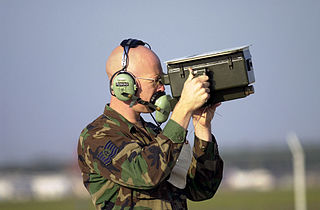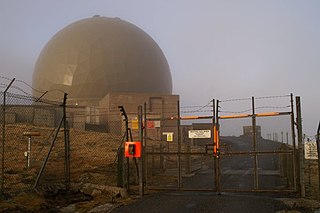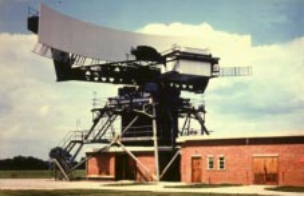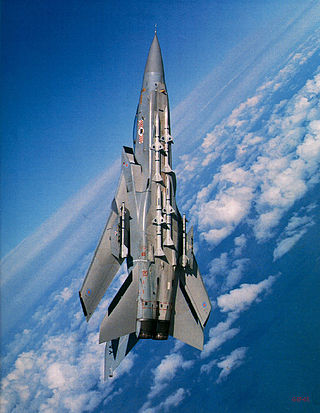
Identification, friend or foe (IFF) is a combat identification system designed for command and control. It uses a transponder that listens for an interrogation signal and then sends a response that identifies the broadcaster. IFF systems usually use radar frequencies, but other electromagnetic frequencies, radio or infrared, may be used. It enables military and civilian air traffic control interrogation systems to identify aircraft, vehicles or forces as friendly, as opposed to neutral or hostile, and to determine their bearing and range from the interrogator. IFF is used by both military and civilian aircraft. IFF was first developed during World War II, with the arrival of radar, and several friendly fire incidents.

ROTOR was an elaborate air defence radar system built by the British Government in the early 1950s to counter possible attack by Soviet bombers. To get it operational as quickly as possible, it was initially made up primarily of WWII-era systems, notably the original Chain Home radars for the early warning role, and the AMES Type 7 for plotting and interception control. Data from these stations was sent to a network of control stations, mostly built underground, using an extensive telephone and telex network.

Remote Radar Head Saxa Vord or RRH Saxa Vord, is a Royal Air Force radar station located on the island of Unst, the most northern of the Shetland Islands in Scotland. As of July 2019 it is once more a fully operational radar station, after closure in 2006. The station's motto Praemoneo de Periculis reflects its role. RAF Saxa Vord is further north than Saint Petersburg in Russia, and on the same latitude as Anchorage, Alaska. The station was named after Saxa Vord, which is the highest hill on Unst at 935 ft (285 m). It holds the unofficial British record for wind speed, which in 1992 was recorded at 197 mph (317 km/h) — just before the measuring equipment blew away.
Linesman/Mediator was a dual-purpose civil and military radar network in the United Kingdom between the 1960s and 1984. The military side (Linesman) was replaced by the Improved United Kingdom Air Defence Ground Environment (IUKADGE), while the civilian side (Mediator) became the modern public-private National Air Traffic Services (NATS).

No. 84 Wing is a Royal Australian Air Force (RAAF) transport wing. Coming under the control of Air Mobility Group (AMG), it is headquartered at RAAF Base Richmond, New South Wales. The wing comprises No. 35 Squadron, operating Aliena C-27J Spartan transport Aircraft; No. 37 Squadron, operating Lockheed Martin C-130J Super Hercules medium transports; and a technical training unit, No. 285 Squadron.

The DRDO Airborne Early Warning and Control System (AEW&CS) is a project of India's Defence Research and Development Organisation to develop an airborne early warning and control system for the Indian Air Force. It is also referred to as NETRA Airborne Early Warning and Control System (AEW&CS).

The British Aerospace Nimrod AEW3 was a proposed airborne early warning (AEW) aircraft which was to provide airborne radar cover for the air defence of the United Kingdom by the Royal Air Force (RAF). The project was designed to use the existing Nimrod airframe, in use with the RAF as a maritime patrol aircraft, combined with a new radar system and avionics package developed by Marconi Avionics.

IFF Mark II was the first operational identification friend or foe system. It was developed by the Royal Air Force just before the start of World War II. After a short run of prototype Mark Is, used experimentally in 1939, the Mark II began widespread deployment at the end of the Battle of Britain in late 1940. It remained in use until 1943, when it began to be replaced by the standardised IFF Mark III, which was used by all Allied aircraft until long after the war ended.

IFF Mark III, also known as ARI.5025 in the UK or SCR.595 in the US, was the Allied Forces standard identification friend or foe (IFF) system from 1943 until well after the end of World War II. It was widely used by aircraft, ships, and submarines, as well as in various adaptations for secondary purposes like search and rescue. 500 units were also supplied to the Soviet Union during the war.
IFF Mark X was the NATO standard military identification friend or foe transponder system from the early 1950s until it was slowly replaced by the IFF Mark XII in the 1970s. It was also adopted by ICAO, with some modifications, as the civilian air traffic control (ATC) secondary radar (SSR) transponder. The X in the name does not mean "tenth", but "eXperimental". Later IFF models acted as if it was the tenth in the series and used subsequent numbers.

The AMES Type 82, also widely known by its rainbow codename Orange Yeoman, was an S-band 3D radar built by the Marconi Company and used by the Royal Air Force (RAF), initially for tactical control and later for air traffic control (ATC).

RX12874, also known as the Passive Detection System (PDS) and by its nickname "Winkle", was a radar detector system used as part of the Royal Air Force's Linesman/Mediator radar network until the early 1980s. Winkle passed out of service along with the rest of the Linesman system as the IUKADGE network replaced it.

The AMES Type 80, sometimes known by its development rainbow code Green Garlic, was a powerful early warning (EW) and ground-controlled interception (GCI) radar developed by the Telecommunications Research Establishment (TRE) and built by Decca for the Royal Air Force (RAF). It could reliably detect a large fighter or small bomber at ranges over 210 nautical miles, and large, high-flying aircraft were seen out to the radar horizon. It was the primary military ground-based radar in the UK from the mid-1950s into the late 1960s, providing coverage over the entire British Isles.

The AMES Type 85, also known by its rainbow code Blue Yeoman, was an extremely powerful early warning (EW) and fighter direction (GCI) radar used by the Royal Air Force (RAF) as part of the Linesman/Mediator radar network. First proposed in early 1958, it was eleven years before they became operational in late 1968, by which time they were already considered obsolete. The Type 85 remained the RAF's primary air defense radar until it was replaced by Marconi Martello sets in the late-1980s as part of the new IUKADGE network.
Radar, Air to Surface Vessel, or ASV radar for short, is a classification used by the Royal Air Force (RAF) to refer to a series of aircraft-mounted radar systems used to scan the surface of the ocean to locate ships and surfaced submarines. The first examples were developed just before the opening of World War II and they have remained a major instrument on patrol aircraft since that time. It is part of the wider surface-search radar classification, which includes similar radars in ground and ship mountings.

The AMES Type 7, also known as the Final GCI, was a ground-based radar system introduced during World War II by the Royal Air Force (RAF). The Type 7 was the first truly modern radar used by the Allies, providing a 360 degree view of the airspace around the station out to a distance of about 90 miles (140 km). It allowed fighter interceptions to be plotted directly from the radar display, a concept known as ground controlled intercept, or GCI.
The AMES Type 84, also known as the Microwave Early Warning or MEW, was a 23 cm wavelength early warning radar used by the Royal Air Force (RAF) as part of the Linesman/Mediator radar network. Operating in the L-band gave it improved performance in rain and hail, where the primary AMES Type 85 radar's performance dropped off. It operated beside the Type 85 and RX12874 in Linesman, and moved to the UKADGE system in the 1980s before being replaced during UKADGE upgrades in the early 1990s.

The Improved United Kingdom Air Defence Ground Environment, normally shortened to either UKADGE or IUKADGE, was the Royal Air Force's (RAF) ground-controlled interception system covering the British Isles during the 1990s. It consisted of a number of ground-based radar sites, links to airborne early warning aircraft and Royal Navy ships, a telecommunications system to send digital data and voice communications on a protected network, and processing systems based on VAX-11/780 computers. The network ultimately contained a dozen long-range radars including four Marconi Martello, two General Electric TPS-592, and six Plessey AR-320.
The HF200 is a height finder radar designed and first built by Decca Radar in 1957, and continuing sales into the 1970s after the division was purchased by Plessey in 1965. It was one of the company's successful heavy radar projects, winning the contract for many of the ROTOR stations in the UK and additional sales around the world with a total production run of about 40 examples. These served into the 1980s, and in one case, 1993, before 3D radars removed the need for separate height-finders.













